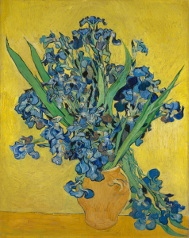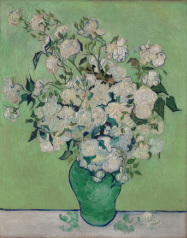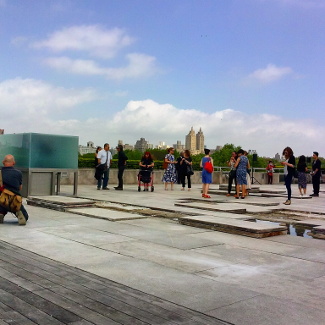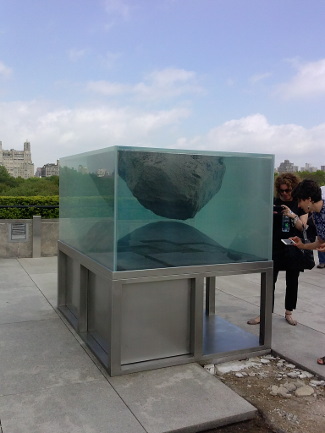CURATOR'S CHOICE SM
Exhibition Reviews
| Home | | Museum
Guide | | International |
| Theater |
Julia Slaff
| A
Morning at the Met - Van Gogh and Huyghe:
The Post-Impressionist painter Vincent van Gogh (1853-1890) captivates the imagination of his viewers with important works such as "Starry Night," "Cafe Terrace at Night," and "Sunflowers." The painting "Sunflowers" is important to our understanding of the works in this exhibition. His combination of a skillful use of optic color mixing, a stippling brush-stroke technique, and a unique faded pastel color palette set him apart from his contemporaries. The Met’s exhibition of "Van Gogh: Irises and Roses" brings together his tetrad of Roses and Irises portraits after "Sunflowers" days and before his institution at Saint-Remy. The gallery setting is intimate. The warm beige walls complement the portraits but do not take away from faded pastel greens, purples, and yellows of the four paintings. The quartet follows the usual van Gogh style: stippling brush work and an optical color palette allows the eyes to move along the organic and inorganic elements of the painting that go forward and behind the picture plane. The powerful brush strokes are applied with a delicacy similar to that of frosting a cake. Clear evidence of separation lies between the two "Irises" and two "Roses" paintings; however, their symmetrical arrangements of verticals to horizontals in the gallery connect them literally and chronologically. Elements of his "Sunflowers" are evident in the first Iris portraits. The final irises and roses paintings disregard any remnant of those sunnier days. The dim gallery setting allows the gold-framed paintings to glow, which is paradoxical considering the dark state he probably had leading up to his time in the St. Remy hospital. One would think the metallic framing would be distracting. Not so. I theorize that their grouping shows the artist’s process of experimentation rather than merely a final product.
Leaving the historical art section of the Met, and riding the elevator up to the fifth floor rooftop, one encounters the work of contemporary French Artist Pierre Huyghe (1962 - ). This is his third Met-specific installation in a series for the Gerald Cantor Roof Garden. Unlike van Gogh, Huyghe for 25 years has rendered works across the media spectrum, a practice common to contemporary artists. The Met’s exhibition press release eloquently describes Huyghe’s artistic motivation as "to create ritualistic situations and immersive encounters." His installation is the subject of a topic much on our minds: how our environment and cultural practices interact with one another.
Huyghe’s garden is simply breathtaking in its raw nature. Entering the green space, one is taken to a hovering pad above the city. The only reminder of one’s cosmopolitan origins is the cityscape horizon line in the distance. The rooftop is unlike one’s vision of a swanky Upper East Side terrace: it does without manicured beds of flowers, except for the semi-trimmed bushes hugging the terrace’s perimeter. Granite rock tiles have been ripped from ground and laid beside the wounds, allowing dirty water to pool in the crevices. An unsightly mixture of exposed earth, past exhibitions, roots of trees, and former Met admission buttons occupy the stagnant water pools. A clear glass tank of water and sparse marine life is the most most intriguing element of the installation. It contains a singular ominous floating rock. Little aquatic life inhabits it, except for a few eels. The walls cloud up as ominous volcanic rock floats in the unsealed tank. It acts as the beating heart of the site. There are two species of aquatic life in it: tadpoles and American-Brook Lampreys. The exhibition is about history far beyond imagination. The installation is a combination of human, animal, plant,
and machine. During opening remarks on opening day, the Met’s
chairwoman of modern and contemporary art, Sheena Wagstaff, noted the
literal and expressive themes are reflective of Central Park’s
geology and long history, which were inspirational to Huyghe’s
design. IF YOU GO |





